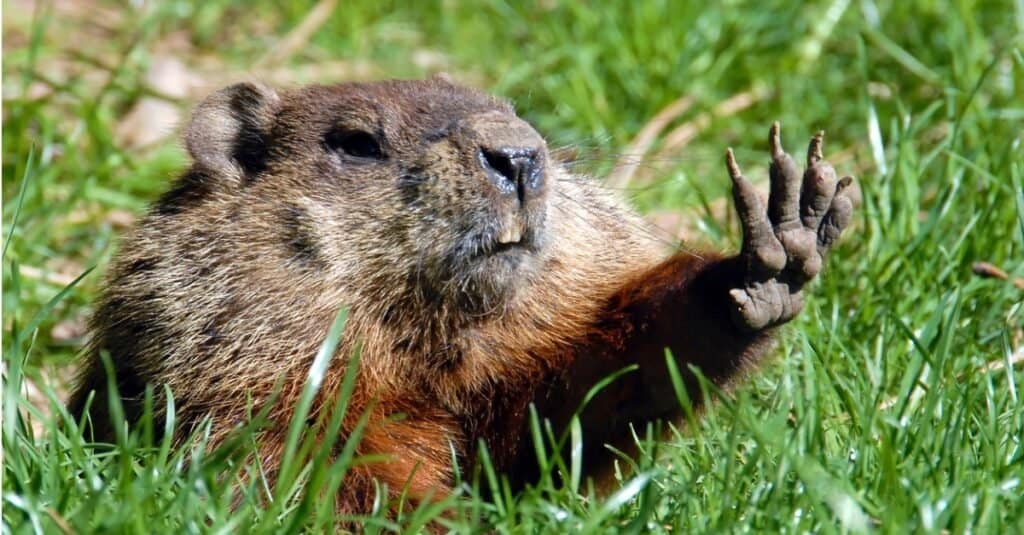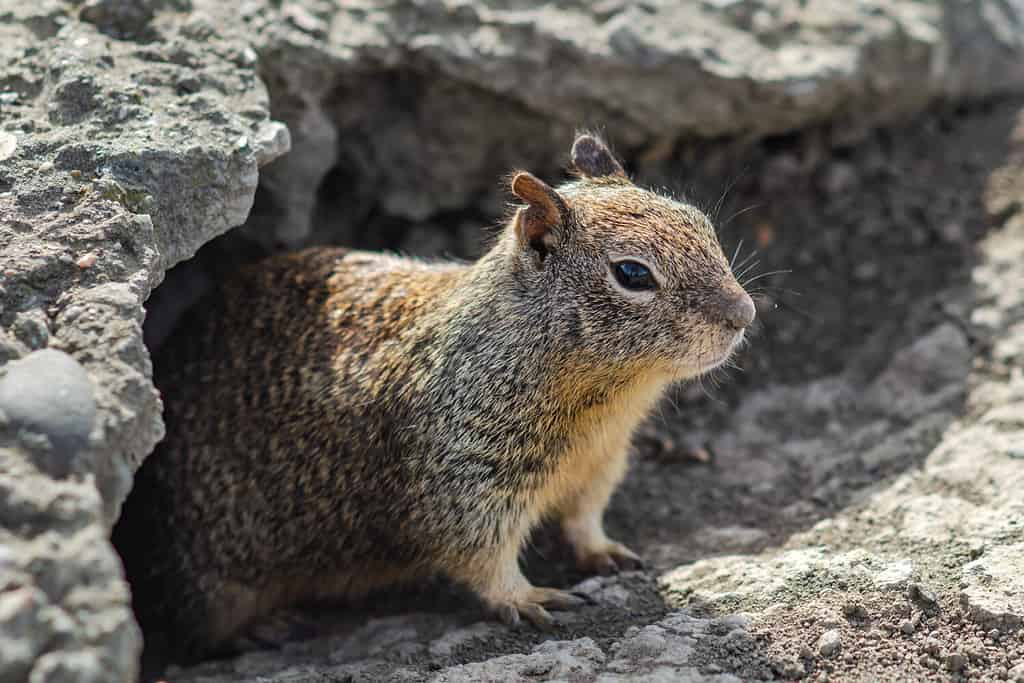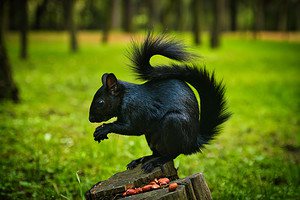Sometimes, it can be helpful to distinguish a single species, like prairie dogs, from the overall family to which they belong. In this case, prairie dogs are one of many types of ground squirrels. In this article, we’re going to parse the subject of a ground squirrel vs prairie dog and show you how they’re different from one another.
We’ve managed to come up with five distinct areas to look at as we try to show how general ground squirrels are as well as how unique prairie dogs are within the family. With that in mind, let’s start by taking a look at the biggest differences between these creatures.
Comparing a Ground Squirrel and a Prairie Dog

| Ground Squirrel | Prairie Dog | |
|---|---|---|
| Size | Weight: less than 1 to 24 pounds Length: 7.2 inches to 30 inches | Weight: 1 to 4 pounds Length: 12 to 16 inches, including their short tails |
| Genera | – Numerous, including Cynomys, Poliocitellus, and Ictidomys | – Cynomys – Several other species, though |
| Location | -Asia, Europe, North America, Central America | – North and Central America |
| Burrowing | – Almost all ground squirrels burrow to some extent – Burrows vary in size based on the social aspects and size of the ground squirrel | – Form “towns” of different prairie dog families – Towns may have over 20 small family groups – Burrow systems can measure from 13 to 109 feet long and reach nearly 14 feet below ground. |
| Social | – Some ground squirrels, including prairie dogs, are very social and live in large groups – Marmots and some other grounds squirrels may live alone | – Form small groups, or coteries, consisting of a male, up to four females, and their offspring – Guards “bark” to signal danger – Barks are specific to the predator, with specific calls for details like color |
The 5 Key Differences Between a Ground Squirrel vs Prairie Dog

Prairie dogs kiss to ensure they are part of the same family.
©Nick Fox/Shutterstock.com
The greatest differences between a ground squirrel and a prairie dog include their size, genera, and location. Ground squirrels comprise several genera, measure from less than 1 pound to 24 pounds and from 7 to 30 inches in length, and live throughout Asia, Europe, North America, and Central America. Prairie dogs only belong to the Cynomys genus, live in North and Central America, and measure from 1 to 4 pounds in weight and 12 to 16 inches in length.
These are just three of the main ways to separate the general class of ground squirrels from the specific prairie dog genus. Let’s take a closer look at the five distinctions we have identified. Once we’re through, you’ll have a more thorough understanding of how to separate these animals from each other.
Ground Squirrel vs Prairie Dog: Genera
The first and most significant difference between a ground squirrel and a prairie dog is that the term “ground squirrel” refers to several different members of the Sciuridae family of squirrels. This umbrella term refers to several different creatures, including marmots, chipmunks, and even prairie dogs.
Knowing this, it should be clear why comparing these creatures is not a typical process. We’re parsing the differences between prairie dogs and the rest of the ground squirrels.
That being said, the prairie dog only refers to a single genus of creatures called Cynomys within the Sciuridae family. That alone makes these creatures vastly different from one another.
Ground Squirrel vs Prairie Dog: Size

The Olympic Marmot is one of the largest ground squirrels to exist.
©Virginie Merckaert/Shutterstock.com
Prairie dogs are among the smaller types of ground squirrels that exist today. The average prairie dog weighs between 1 and 4 pounds. Moreover, these animals only measure about 12 to 16 inches long, and that accounts for their small tails.
Ground squirrels can vary in size by quite a bit. Some of them weigh less than one pound, and others can exceed the size of a prairie dog and weigh 30 pounds. Moreover, they can grow between 7 inches at their smallest to 30 inches at their largest. A marmot, one of the largest ground squirrels, weighs about 24 pounds and grows 29 inches at its maximum!
This shows the variety that exists in ground squirrels and the relatively small range of sizes available for prairie dogs.
Ground Squirrel vs Prairie Dog: Location
Ground squirrels live in far more places than prairie dogs alone. For example, ground squirrels can be found in Asia, Europe, North America, and Central America. However, prairie dogs are only found in North America and Central America. They are not found on two of the same continents where we can find other species of ground squirrels.
Ground Squirrel vs Prairie Dog: Burrowing

Prairie dogs have a collection of burrows called towns.
©Zoltan Tarlacz/Shutterstock.com
Just about all ground squirrels burrow in some way, whether they dig a small spot for themselves or have advanced tunnel systems that house hundreds of their family members. Prairie dogs have some of the largest tunnels in terms of overall size and interconnectivity.
Prairie dogs dig many burrows in the same area. Each burrow can measure between 13 and 100 feet long and reach about 14 feet underground. Every separate burrow is typically home to a male, a few females, and all the young offspring that they have produced. Once these prairie dogs grow up enough, they create their burrows, often nearby. The collection of these burrows is called a town.
A single town can house up to 20 small groups, taking up dozens of acres of land, each with several entrances and exits into the system. Prairie dogs are complicated creatures that know how to dig well.
Ground Squirrel vs Prairie Dog: Social

Woodchucks tend to be less social than other ground squirrels.
©iStock.com/mirecca
Prairie dogs are some of the most social types of ground squirrels. They form small groups that are sometimes called coteries. These groups have one male, up to four females, and their offspring. They live in the towns we have described in the prior section, and each town has guards watching for danger.
If they spot danger, they will “bark”, and it’s believed that each of these barks is specific enough to relay information about the size and even the color of the predator. Some scientists believe that this is true altruism, and others think that it is a ploy to create chaos so that the caller is less likely to get caught.
Regardless, the sociability and the warning behavior of these ground squirrels are found in many other species. Yet, some species of ground squirrels are less social. For example, some kinds of marmots might live with one partner or none for most of the year. The woodchuck, a type of marmot, is solitary unless it’s breeding season. All told, these creatures tend to live in groups with at least one other ground squirrel.
As a final recap, all prairie dogs are ground squirrels, but not all ground squirrels are prairie dogs. The unique qualities of the prairie dogs make them an interesting member of the genus to study. Still, just about all ground squirrels have some interesting traits that make them a pleasure to learn about.
Bonus: Is It Bad To Have Ground Squirrels In Your Yard?

Is the ground squirrel living in your garden a friend or foe?
©Iv-olga/Shutterstock.com
Unless you live on a prairie and own land where a prairie dog colony has already taken up residence, your chances of dealing with prairie dogs in your yard are slim. However, ground squirrels are common, and definitely critters that you may encounter on your property. The question is, are they bad (or good) to have around?
Ground squirrels, like other rodents, can cause problems for humans. Firstly, their burrowing can cause yard damage. They leave holes in the lawn that can be hazards if you step in them, they can dig under home foundations, patios, and decks, as well as upset gardens.
These critters can also carry diseases like leptospirosis, rabies, and the bubonic plague. They multiply quickly, so a yard infestation of them can be problematic, as they can pass these diseases to domestic animals and humans.
On the plus side, ground squirrels are given credit by some researchers as helping to control insect populations, and creating habitats for other wild animals, who may take up residence in their burrows. They also provide a tasty meal for birds of prey, snakes, weasels, and foxes. Even more interesting, they provide soil aeration (free of charge) and seed dispersal.
The photo featured at the top of this post is © Michael Chatt/Shutterstock.com
Thank you for reading! Have some feedback for us? Contact the AZ Animals editorial team.






